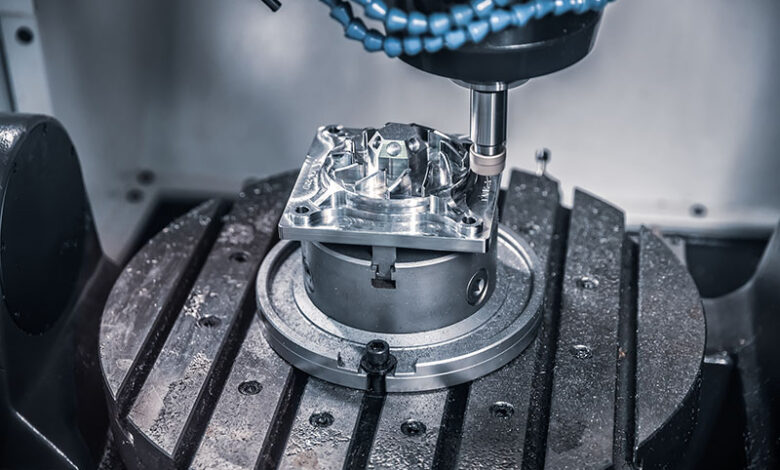How to Control a CNC Machine in a CNC Machine Shop?

A CNC milling machine operates with a metal workpiece secured on the machine table.
CNC machines have transformed manufacturing by automating precise and complex tasks. Computer programs control these machines and produce complex parts with high accuracy and consistency. These machines are essential for boosting productivity and maintaining quality in a CNC machine shop. Knowing how to control a CNC machine is vital for smooth operation.
This process includes several key steps, such as setting up the machine, loading the program, calibrating the tools, and monitoring the machining process. By following a structured approach, operators can enhance performance, reduce errors, and uphold safety standards, thus maximizing the efficiency of CNC technology in manufacturing.
This article offers a detailed, step-by-step guide on controlling a CNC machine. It covers everything from the dos and don’ts of operating a CNC machine to the different CNC machines available in a machine shop.
What is a CNC Machine?
A CNC machine is an advanced manufacturing tool that automates and controls machining processes through computer programming. These machines excel in performing various tasks such as cutting, milling, drilling, and turning with high precision and consistency.
CNC machines convert digital designs from computer-aided design (CAD) software into specific commands. These commands direct the machine’s movements and actions, transforming materials like metal, plastic, wood, and composites into detailed parts and components.
The key benefit of CNC machines is their ability to produce complex and intricate designs with high repeatability and minimal human intervention, boosting production efficiency and reducing the risk of human error.
Types of CNC Machines
A 5-axis CNC machine is in operation and capable of producing complex geometries.
CNC machines are essential tools in manufacturing. Each serves specific functions with precision and efficiency. The primary types of CNC machines are CNC turning and CNC milling machines, each with distinct capabilities and applications.
CNC Turning
CNC turning machines, also known as CNC lathes, specialize in creating cylindrical parts. They rotate the workpiece while a cutting tool moves along the axis of rotation, shaping the material to the desired form.
CNC lathes are primarily used for producing round components like shafts, bushings, and screws. They can perform various operations, including facing, threading, knurling, and grooving. Critical elements of a CNC lathe include the spindle, which rotates the workpiece, and the tool turret, which holds multiple cutting tools.
CNC Milling
CNC milling machines excel at creating complex parts like pockets, slots, holes, and contours by removing material from a workpiece using a rotating cutting tool. These machines are highly versatile and can produce various shapes and features. They operate on multiple axes, allowing for the creation of complex designs. Critical components of a CNC milling machine include the spindle, worktable, tool changer, and control panel.
CNC milling has two primary types: horizontal and vertical milling machines. The horizontal milling machines enable simultaneous cutting of multiple surfaces and efficient chip evacuation. They are Ideal for heavy-duty machining operations. Meanwhile, vertical milling machines provide easy access to workpieces from various angles. They are well-suited for operations requiring shallow cuts or sophisticated detailing.
How to Operate a CNC Machine – Hermle 5-axis CNC Milling Machine
The loading of a CNC program into the machine’s control system.
Operating a CNC machine, such as the Hermle 5-axis CNC milling machine, requires technical knowledge, practical skills, and adherence to safety protocols. Here are steps on how to operate the Hermle 5-axis CNC milling machine, including dos and don’ts:
- Preparation for Safe and Efficient Machining
- Safety First:
Prioritize adherence to workshop safety protocols. Always consult the Hermle 5-axis CNC milling machine manual and follow workplace-specific safety regulations. This includes wearing appropriate Personal Protective Equipment (PPE) such as:
- Safety Glasses: Wear ANSI Z87.1-compliant safety glasses to protect your eyes from flying debris.
- Hearing Protection: Use earplugs or earmuffs with an appropriate Noise Reduction Rating (NRR) to safeguard against machine noise.
- Fitted Clothing: Avoid loose clothing, dangling jewelry, or long hair that could pose hazards.
- Foot Protection: Wear closed-toe shoes with slip resistance to prevent accidents.
- Workpiece Setup for Secure Machining
Ensure to secure the workpiece firmly in the designated fixture using appropriate clamping methods:
- Fixture Selection: Choose a fixture that provides optimal support and rigidity for the workpiece geometry.
- Clamping Techniques: Apply proper clamping pressure using clamps, screws, or vises to prevent workpiece movement.
- Collision Avoidance: Ensure the workpiece and clamping system do not interfere with programmed toolpaths during simulation or dry runs.
- Tooling Preparation for Optimal Performance
Inspect cutting tools for wear, chipping, or breakage before use:
- Tool Selection: Choose the correct cutting tool based on program requirements and machining material.
- Tool Balancing: Ensure proper tool balance to minimize vibrations during operation.
- Tool Installation: Securely fasten the cutting tool into the appropriate holder with the correct tightening torque.
2. Machine Setup
- Power Up with Proper Sequence:
Follow the manufacturer’s instructions in the machine manual to power up the Hermle 5-axis CNC milling machine. This typically involves turning on the main power switch, initializing the control system, and performing system checks to ensure all subsystems function correctly.
- Program Loading for Precise Control
Load the CNC program onto the CNC machine’s control unit. Depending on the specific machine model and software compatibility, this might involve transferring the program via a USB flash drive or network connection. Once loaded, verify the program details on the control panel screen, such as estimated machining time, toolpath visualization, and specific program notes.
- Tool Setting for Accurate Machining:
Utilize the Hermle 5-axis CNC milling machine’s automatic tool setting function to establish each tool’s length and diameter. This data is crucial for precise machining, as even minor discrepancies can lead to dimensional inaccuracies in the finished workpiece. The Hermle CNC machine tool setting process typically involves the machine touching a pre-programmed tool setter with each tool to determine its precise offset values.
- Dry Run for Collision Detection:
Before initiating the machining process, performing a dry run of the program is essential. A dry run simulates the entire program without activating the spindle or coolant system. This allows for visual verification of several essential aspects:
- Toolpath Accuracy: Observe the toolpath on the machine’s control panel screen and visually inspect its movements to ensure they align with the programmed path. This helps identify any potential programming errors that could lead to machining inconsistencies.
- Collision Detection: Pay close attention to the programmed toolpaths for the fixtured workpiece and surrounding machine elements. During movements, look for potential collisions between the tool and the fixture, clamps, or other machine components.
- Program Stop Points: The dry run also allows you to identify any program stop points where the machine might pause for tool changes or operator intervention. This helps ensure you are prepared for these pauses during the machining process.
3. Machining Process
- Spindle and Coolant Activation for Optimal Cutting:
Once the dry run is successful and you are confident about the program’s accuracy, activate the spindle and coolant system according to the program parameters. Ensure proper coolant flow is directed towards the cutting zone. The coolant is vital in controlling temperature and flushing away chips and debris created during machining, ensuring a clean cutting zone and optimizing surface finish.
- Cycle Start for Program Execution:
Press the designated start button on the Hermle 5-axis CNC machine’s control panel to initiate the machining cycle. The machine will execute the program automatically, controlling tool movement, spindle speed, feed rate, and coolant flow based on the programmed parameters.
- Monitoring for Process Awareness:
During the machining process, it is crucial to maintain visual observation of the operation. Pay attention to the following:
- Machining Sounds: Listen for unusual sounds that indicate tool breakage, excessive vibrations, or other potential malfunctions. A trained operator can often identify potential issues based on subtle auditory cues.
- Coolant System: Monitor the coolant system for proper flow and ensure the coolant reservoir level remains adequate throughout the machining cycle. Replenish coolant as needed to maintain optimal cutting conditions.
- Chip Evacuation: Observe the chip evacuation process to ensure chips are not accumulating in the work area. Excessive chip buildup can trap heat, impacting tool life and surface finish.
4. Completion and Shutdown for Proper Care:
- Cycle End and Power Down Sequence:
The Hermle 5-axis CNC milling machine will halt upon program completion. Allow the spindle to stop entirely before disengaging the coolant system. Then, follow the manufacturer’s recommended shutdown sequence outlined in the machine manual. This typically involves powering down the control unit, spindle, coolant system, and any additional machine components in a specific order.
- Tool Removal with Precautionary Measures:
After ensuring all axes are stationary and the machine is completely shut down, carefully remove the tools from the spindle. Depending on the specific machine model, this might involve using a tool release mechanism or a manual tool changer.
- Workpiece Removal with Safety Focus:
Only after verifying that all machine movements have ceased should the finished workpiece be unclamped and removed from the fixture. When handling the workpiece, utilize appropriate lifting techniques to avoid injuries.
- Machine Cleaning and Maintenance for Upkeep:
Clean the machine work area and tools to remove any debris or chips accumulated during the CNC machining process. Perform routine maintenance tasks specified in the Hermle 5-axis CNC milling machine manual.
Here’s a table summarizing the dos and don’ts when operating a CNC machine like the Hermle 5-axis CNC milling machine:
| Dos | Don’ts |
| Adhere to safety protocols and guidelines | Bypass safety interlocks and guards |
| Undergo comprehensive training | Operate without proper authorization or supervision |
| Conduct regular preventive maintenance | Exceed specified operating limits |
| Maintain a clean and organized work area | Ignore machine warning signs and alarms |
| Document machining parameters and results | Neglect to communicate operational issues or concerns |
| Follow established machining procedures | Override emergency stop mechanisms |
Conclusion
Mastery of CNC machine control enhances productivity and contributes to the success and competitiveness of CNC machine shops. With a clear understanding of these procedures for CNC machines like the Hermle 5-axis CNC milling machine and adherence to dos and don’ts, operators can maximize the potential of CNC machines while ensuring safety and quality. As technology advances, continuous learning and adaptation to new techniques and advancements will further optimize CNC machine operations, fostering innovation and excellence in manufacturing.



